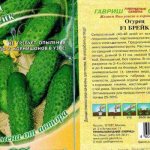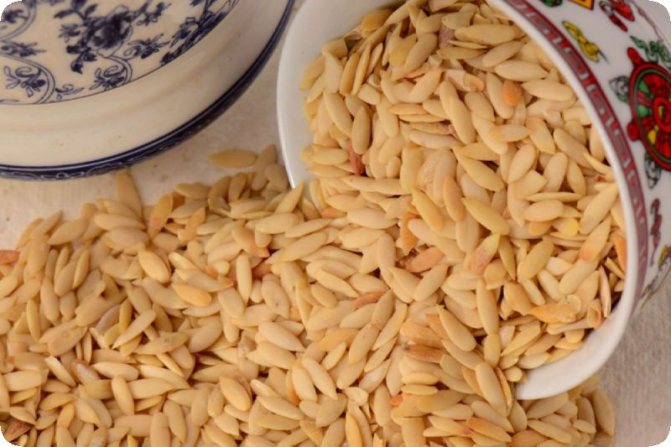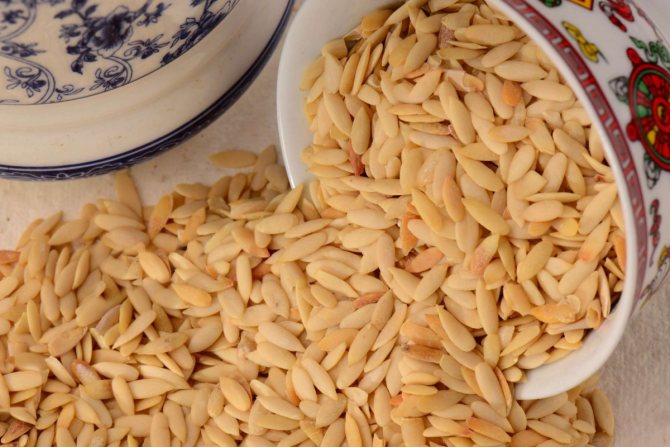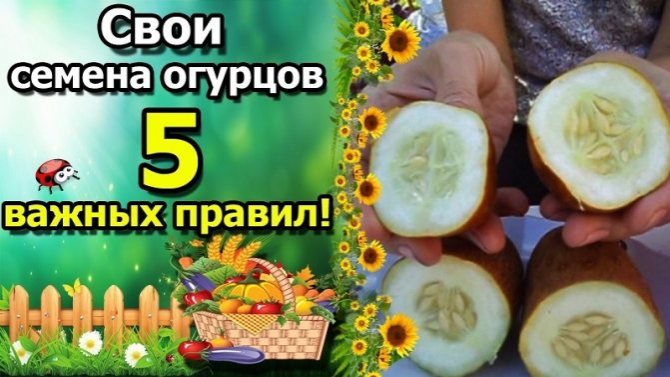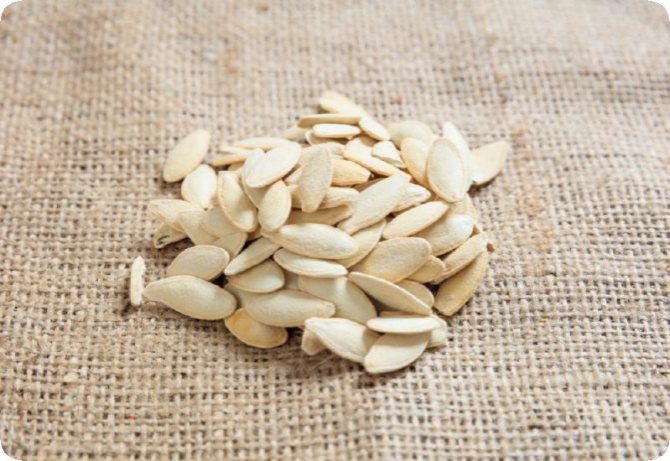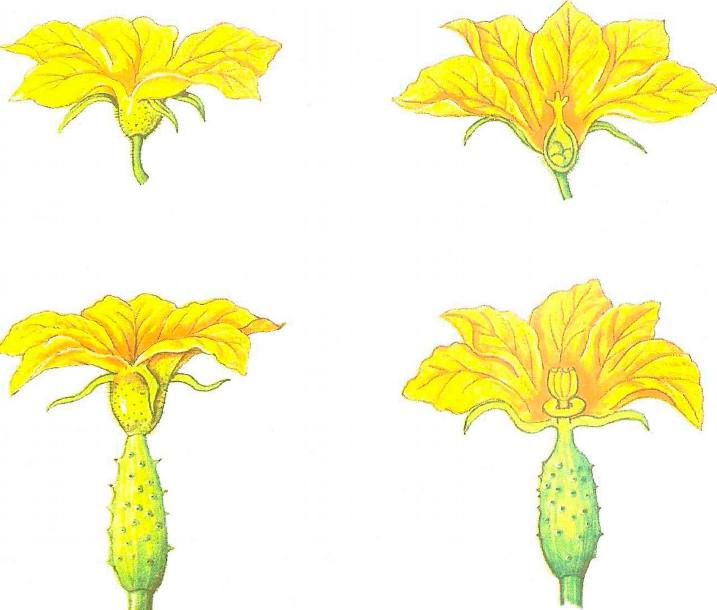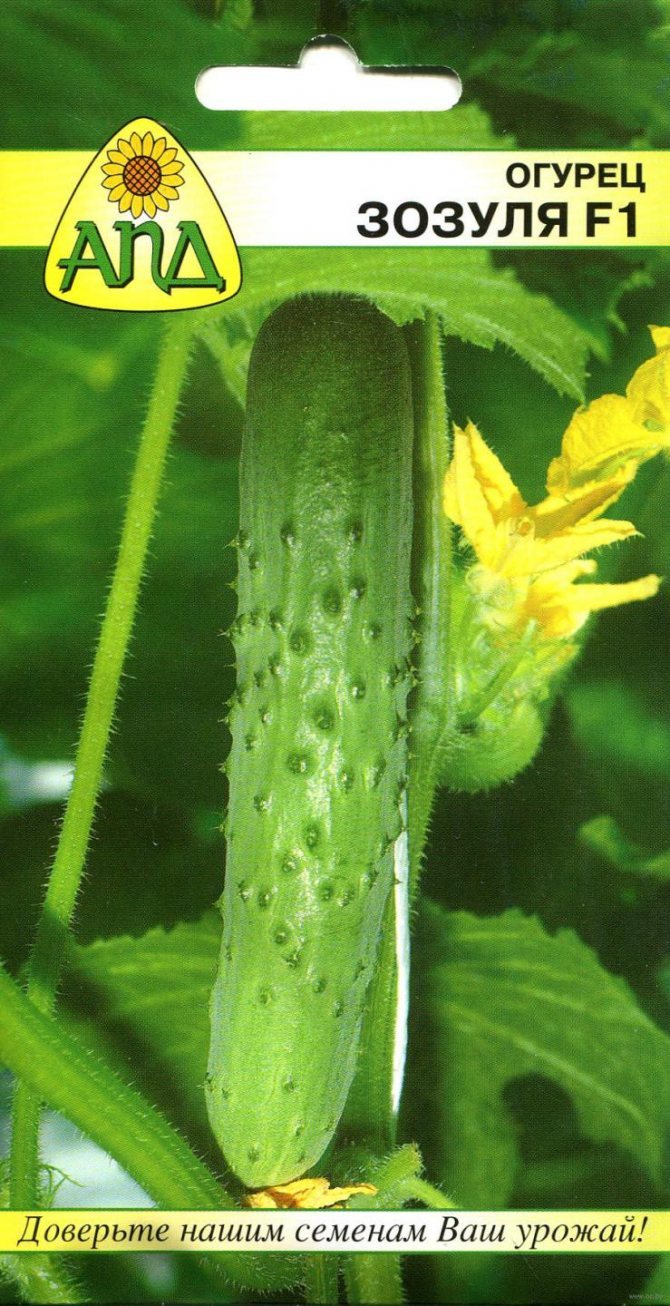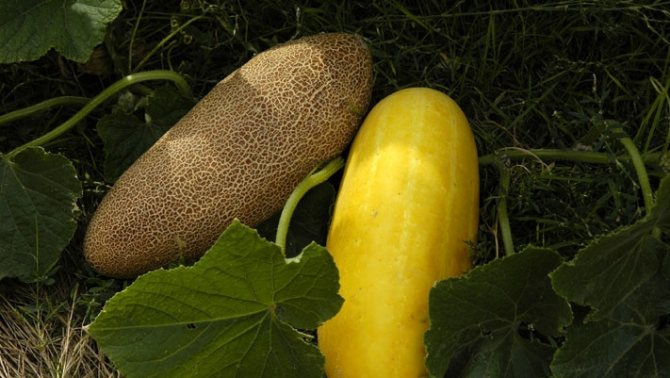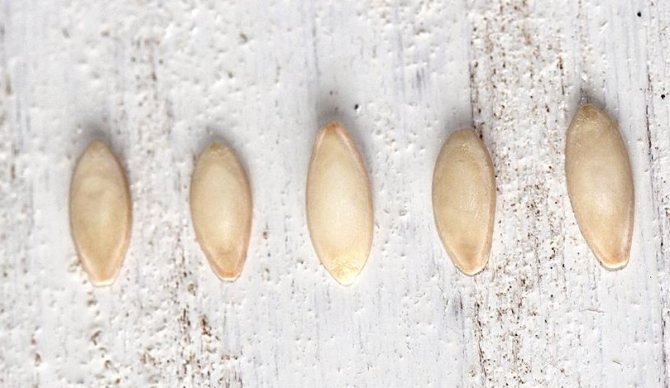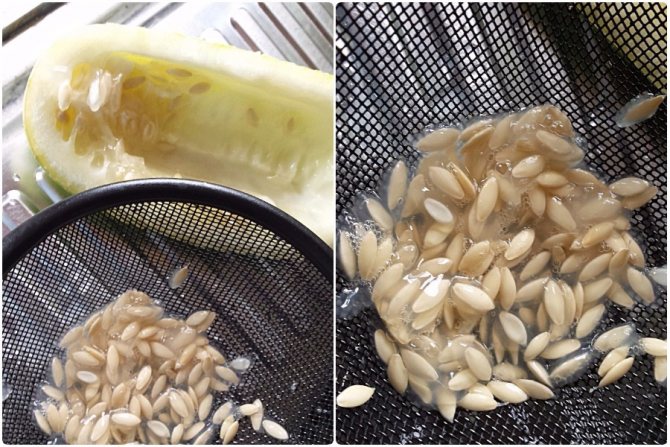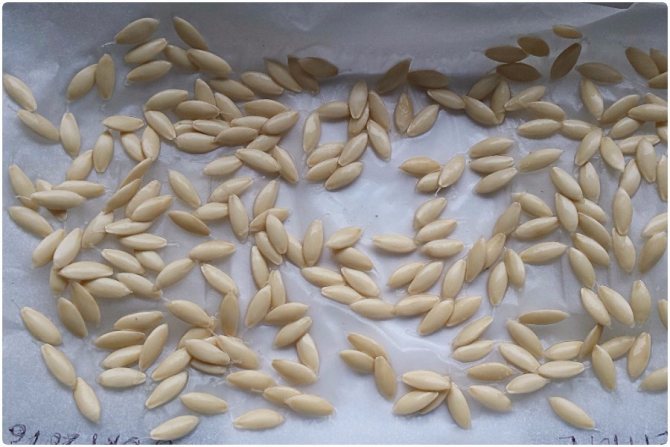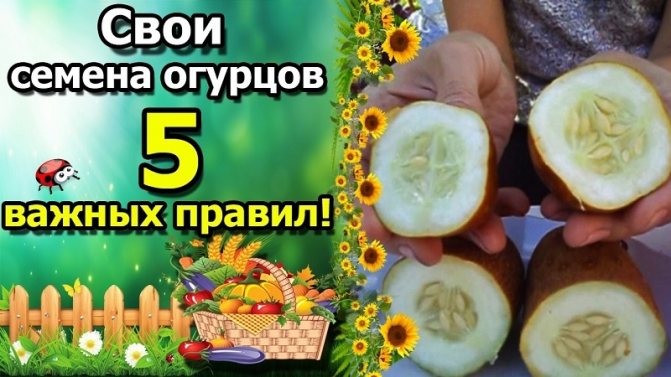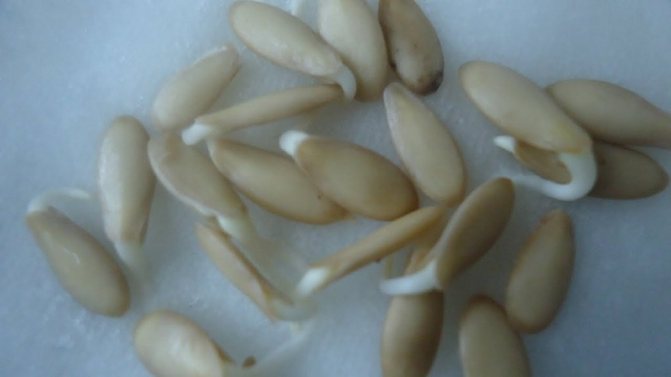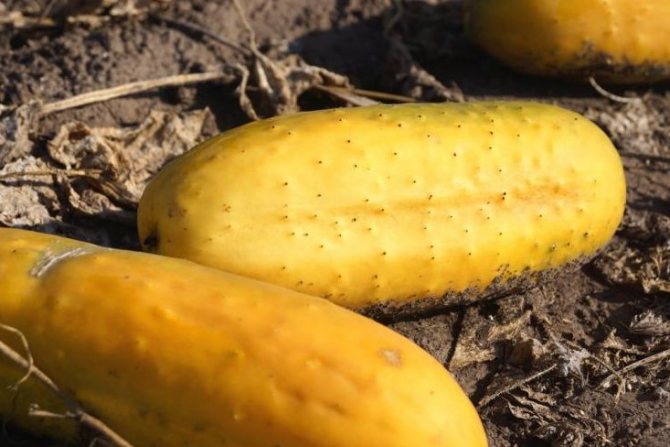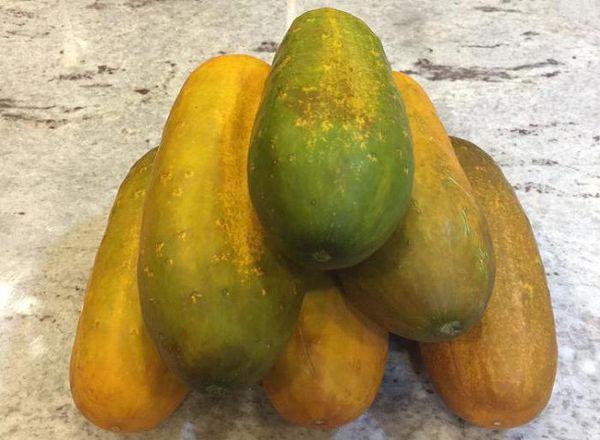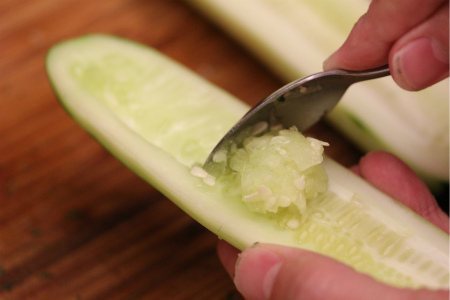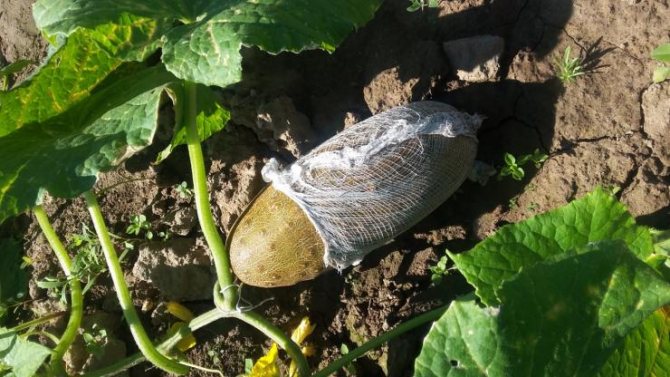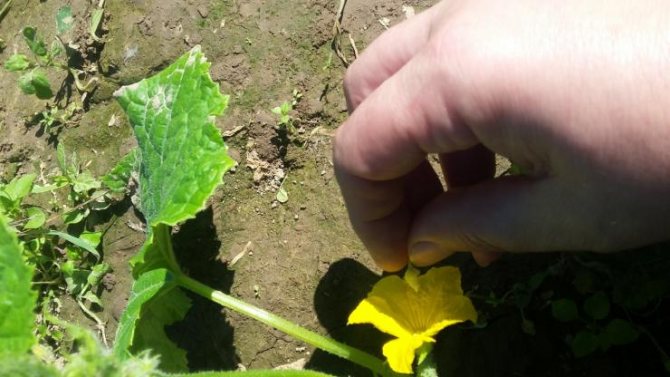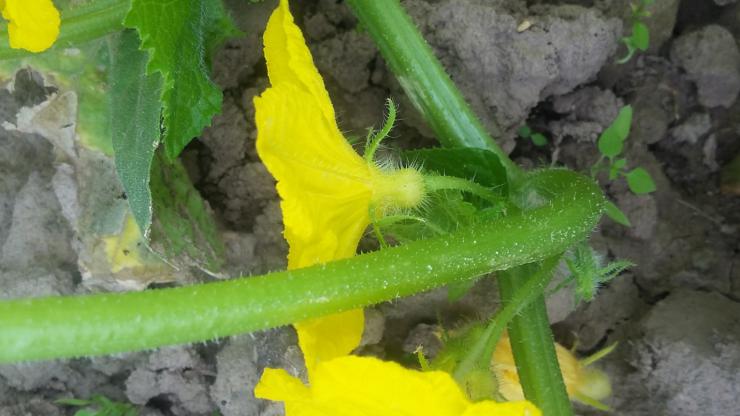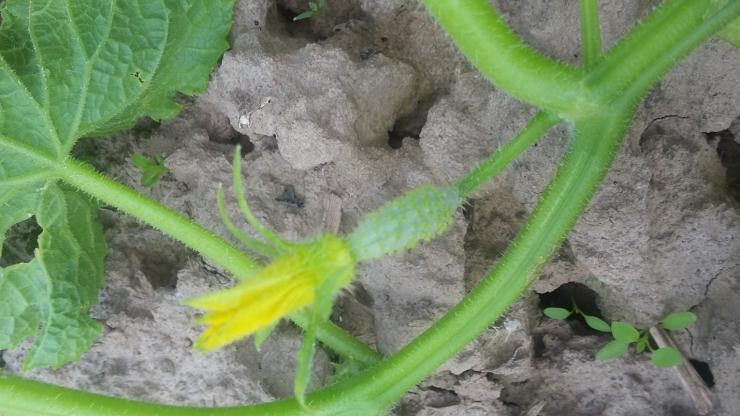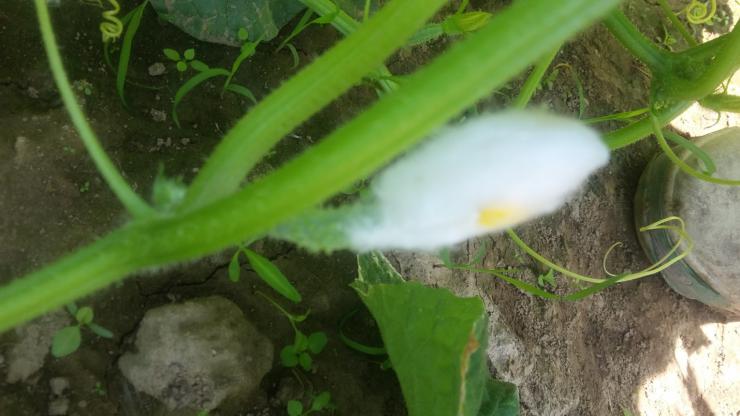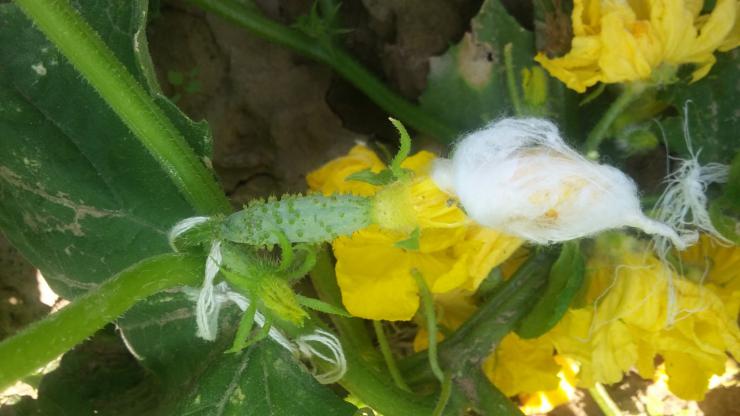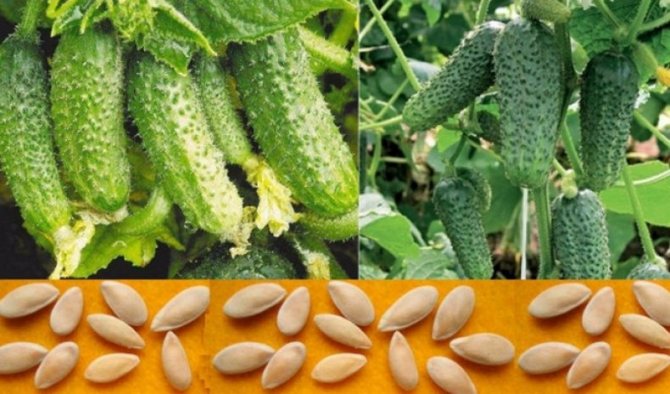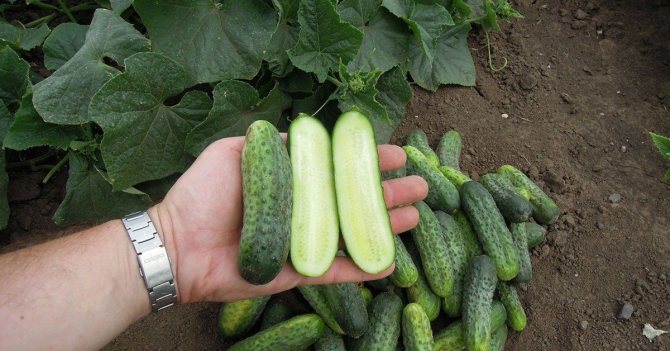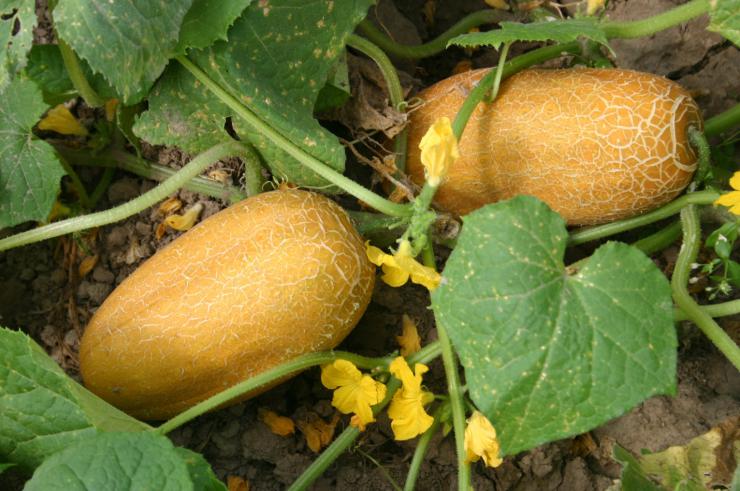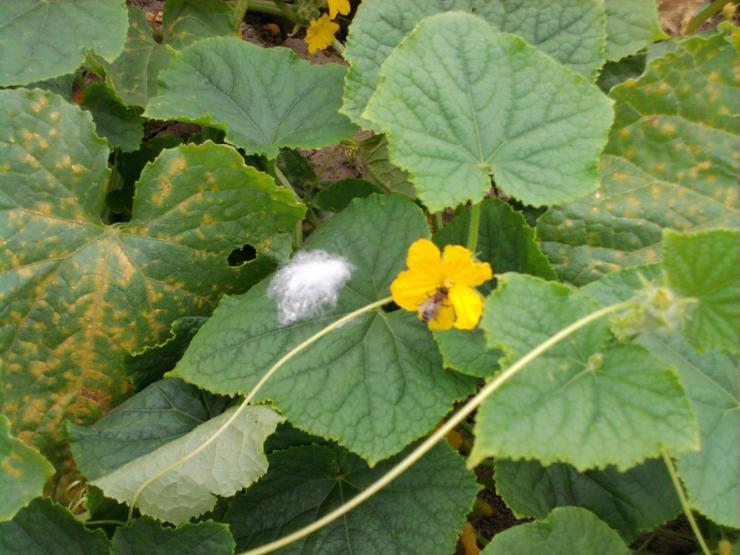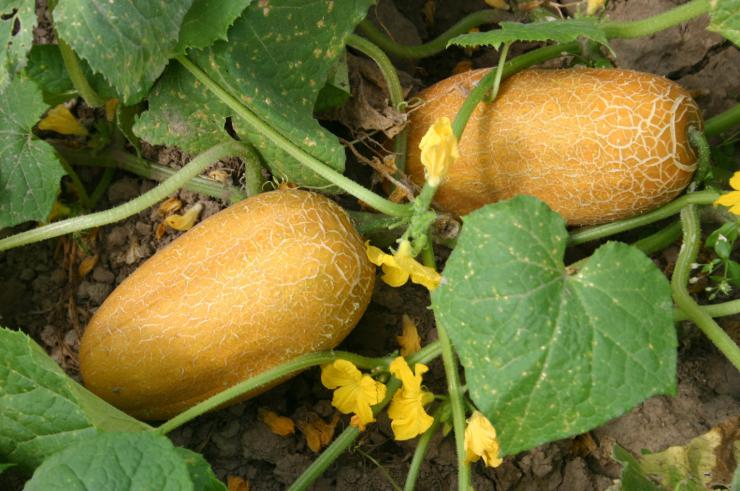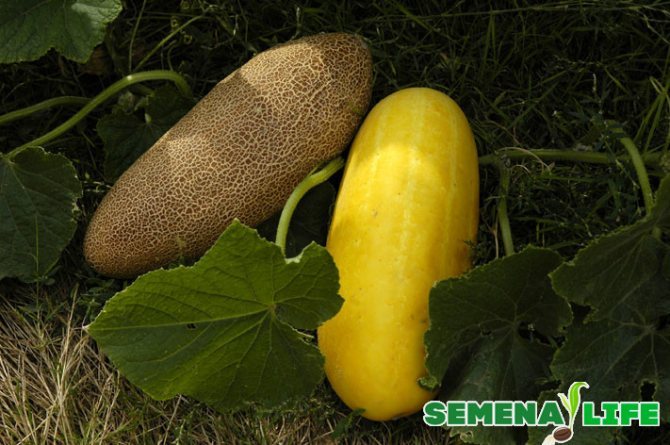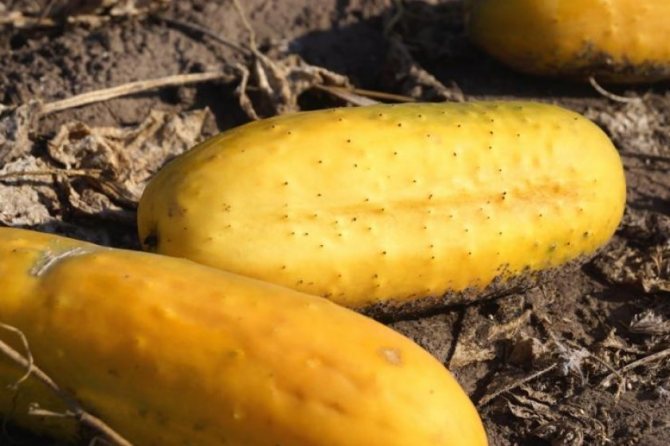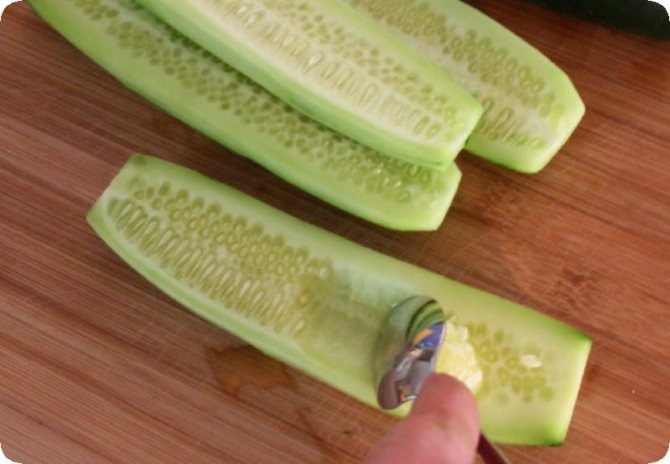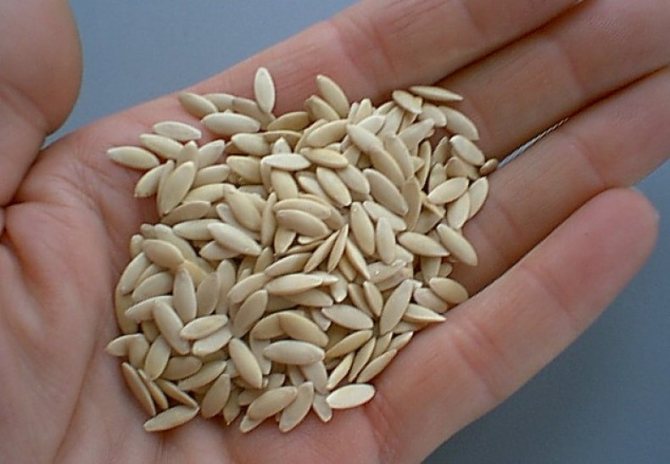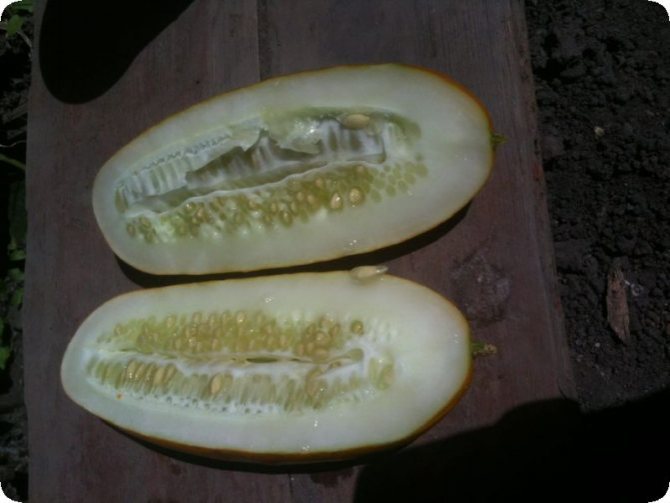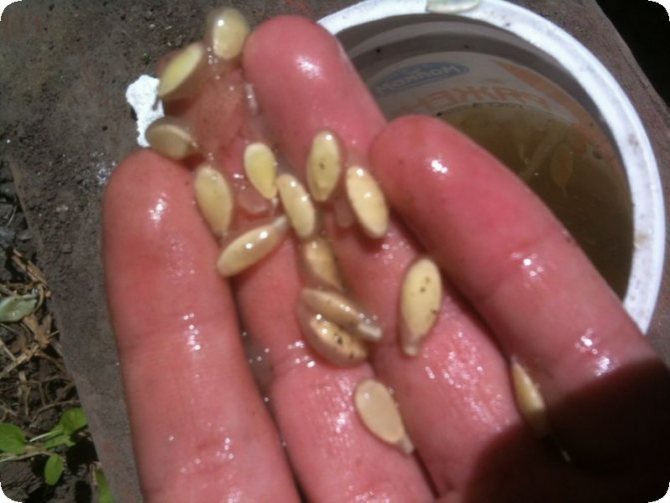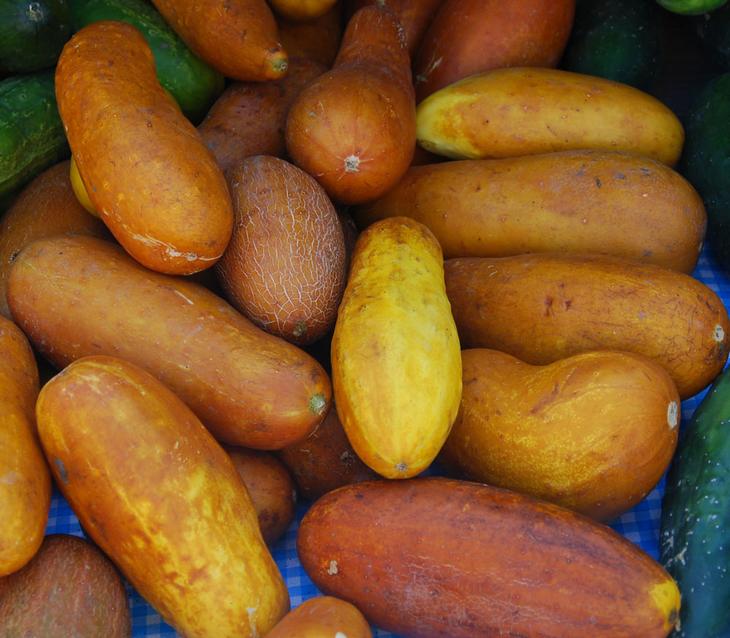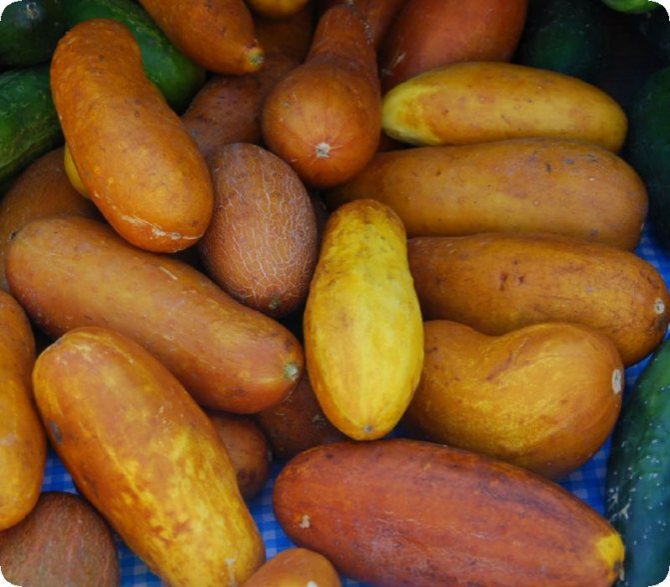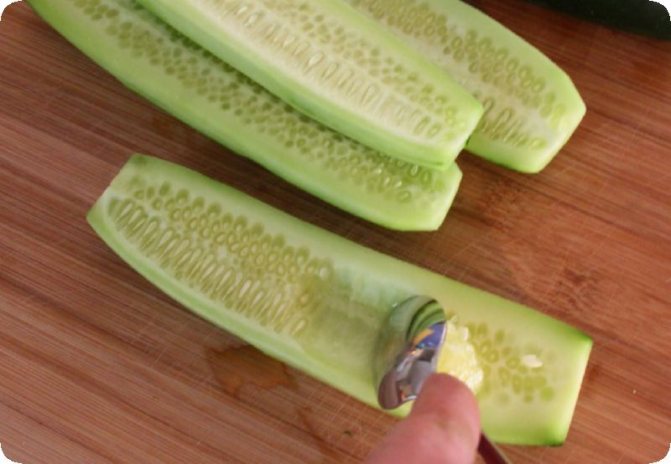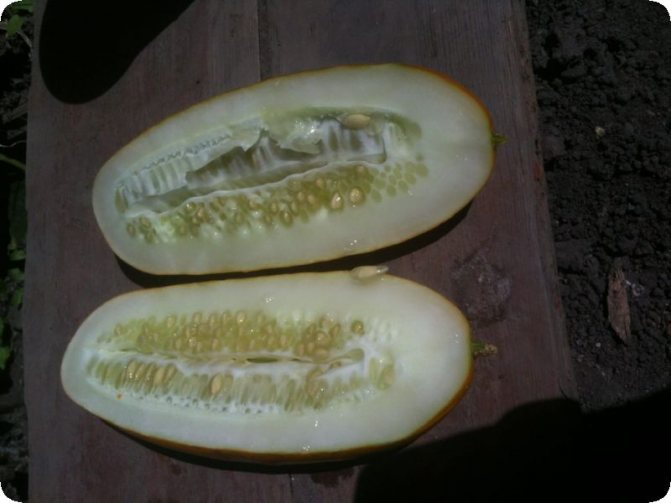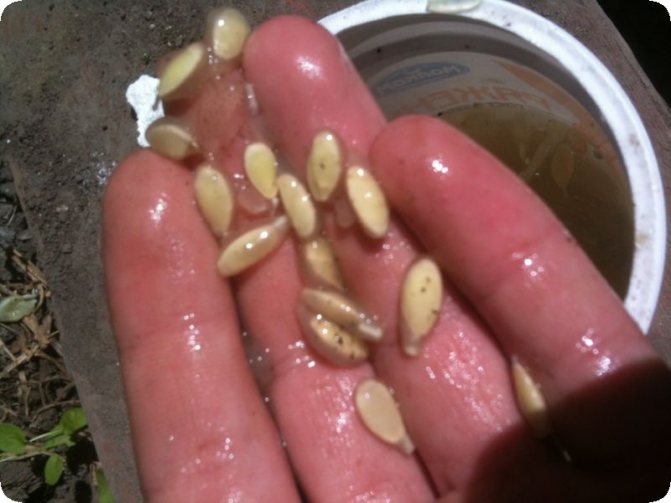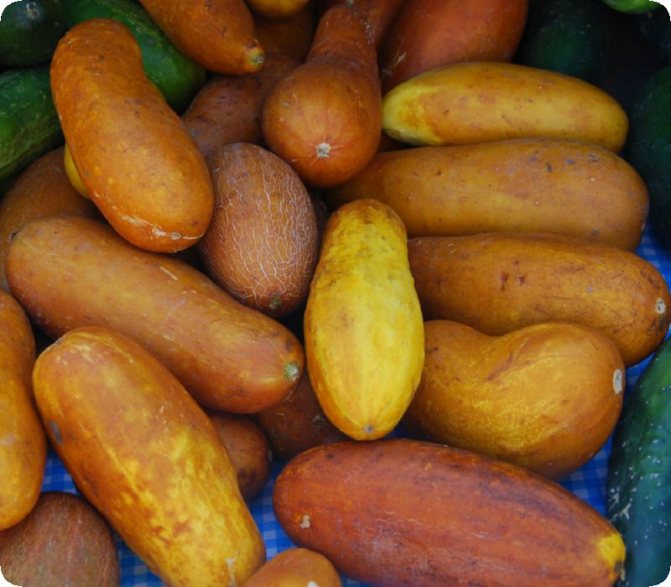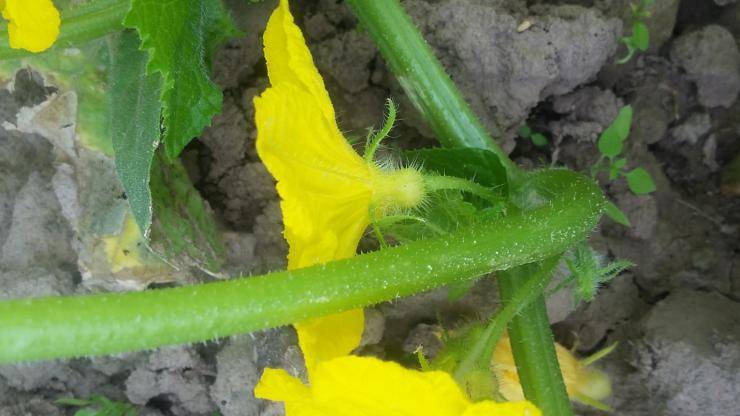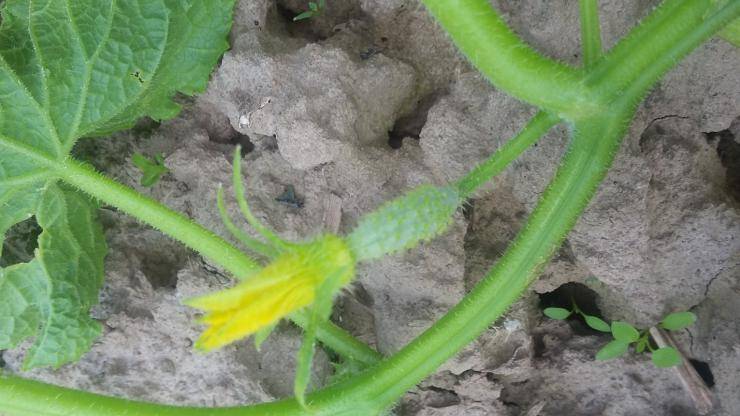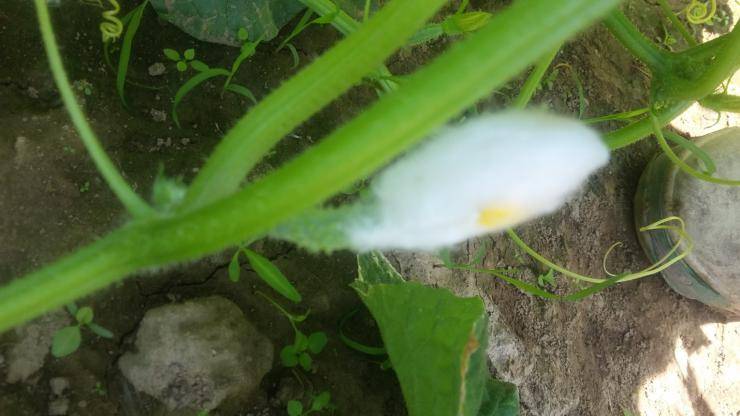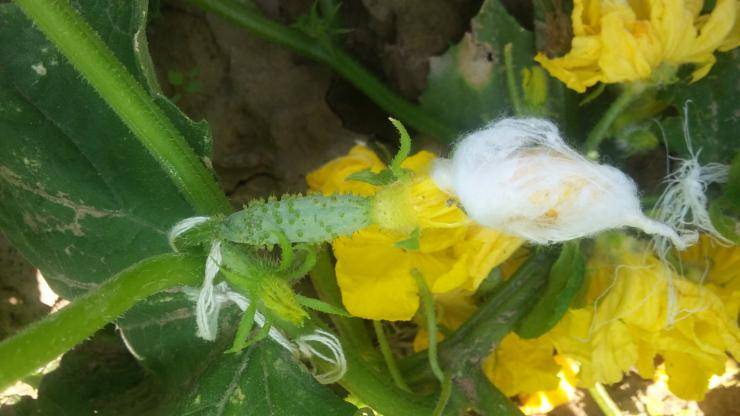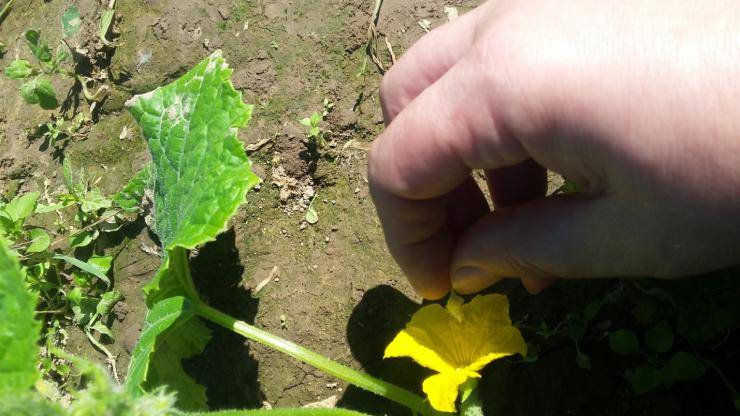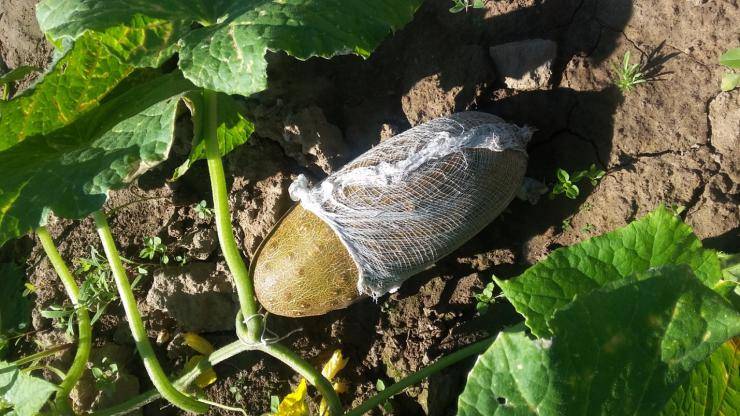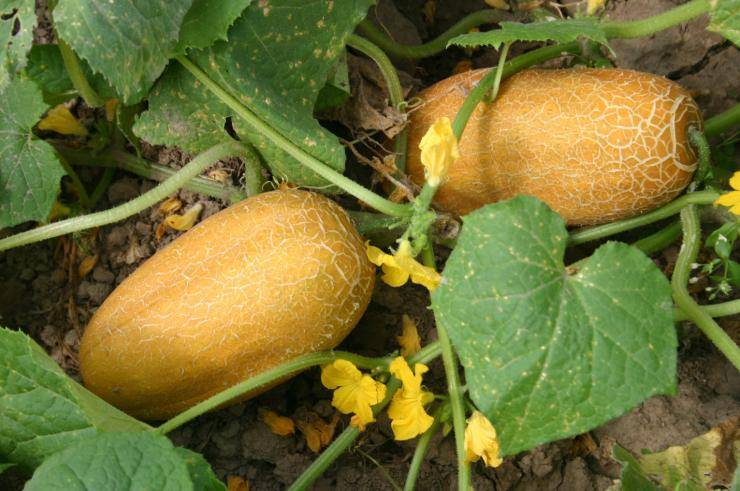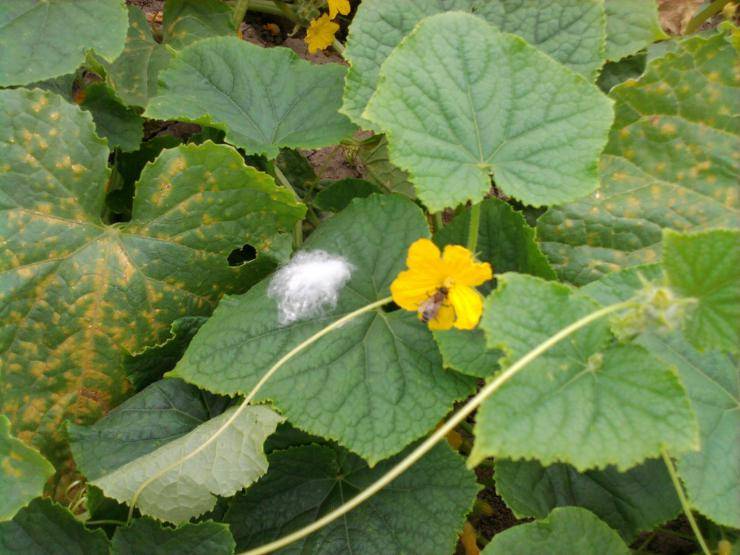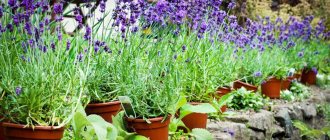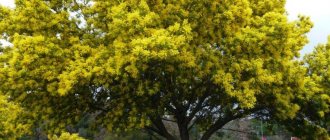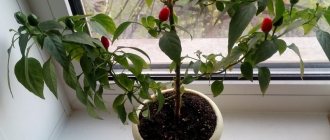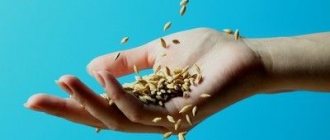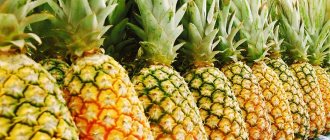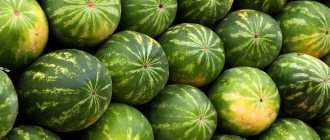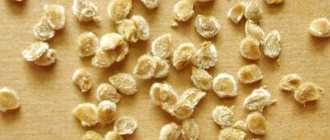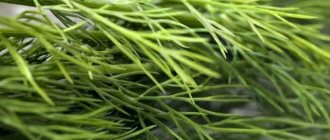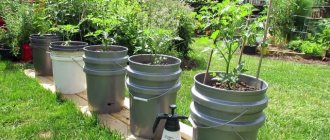Rule 1. Know the variety
With cucumber beds, you know what you are sowing. Common varieties and hybrids are genetically distinct. If hybrids were used (the label is marked F1), then the venture with further production can be left.
The resulting seeds will sprout, grow well, bear fruit, but most of their qualities will be lost: yield, fruit size, resistance to diseases, adverse conditions, salting properties, etc.
Perhaps a parthenocarpic hybrid will require pollination, there will be no bundle type of fruit formation, the growing season will change - the time from germination to fruiting, bitterness will appear and the cucumber will become unsuitable for fresh consumption.
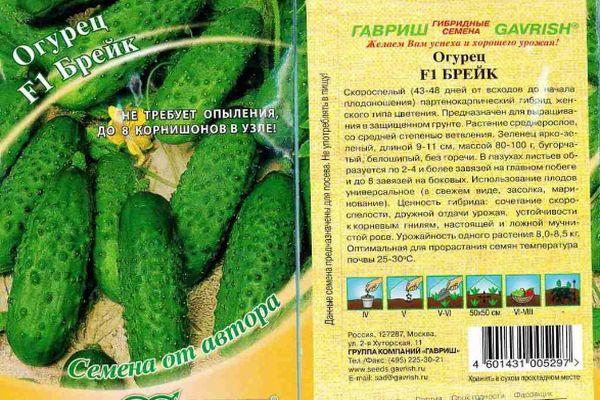
Watch the label carefully: F1 is a hybrid that will not pass on its qualities to offspring. Photo:
For seeds, take common varieties of cucumbers that were not bred by crossing. This option gives 100% hit in the variety and compliance with the characteristics. The best cucumbers for getting seeds with your own hands in the middle lane are:
- Vyaznikovsky;
- Lotus;
- Kustovoy;
- Far Eastern;
- Winner;
- Nezhinskiy;
- Cascade;
- Erofei;
- Swag.
Cucumber seeds have a peculiarity: the longer they are stored, the better they germinate. Three- and five-year seeds give high yields. Stored for more than 6 years have reduced germination.
What varieties should be harvested
The future harvest depends on the quality of the selected seeds. Experienced vegetable growers recommend picking them only from ripe cucumbers taken from the best lash. Such cucumbers have already clearly demonstrated that they are able to bear fruit well, easily adapting to the specific weather conditions of the area.
Harvesting seeds is not a laborious process, but a responsible one, so it is important to take into account all the recommendations of vegetable growers. First of all, you need to leave cucumbers with a square section to collect seeds. Such a tetrahedral fruit is considered a female plant, it is distinguished by the presence of four seed chambers. It is outwardly easy to distinguish a male cucumber, since it has a triangular shape.
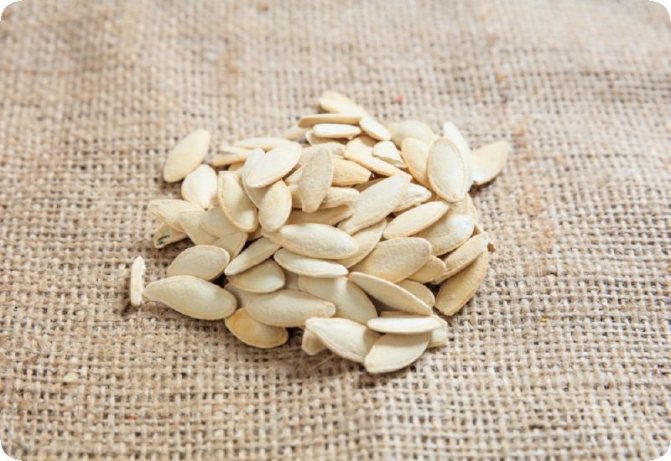

When collecting seeds, it is important to pay attention to the varieties that you like:
- taste;
- productivity;
- appearance.
Vegetable growers remind that cucumber is a cross-pollinated plant. If different varieties of cucumbers were planted on two adjacent beds at a very close distance from each other, it will be impossible to eliminate the risk of pollen from one plant to another of different varieties. As a result, the collected seeds will no longer meet the quality characteristics that you liked when growing cucumbers of a particular variety.
How to store the resulting material for sowing
It will take several days for the cucumber seeds to dry completely. After that, they must be properly stored. The first step is to prepare paper reminders, which indicate the name of the variety and the date of placement for conservation. For packing the obtained seeds, paper envelopes or fabric bags are prepared.
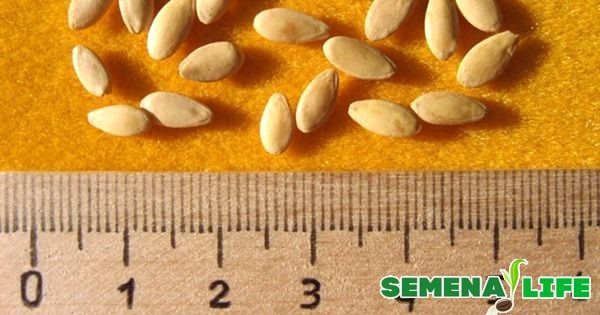

All cucumber seed containers are stored in a cool dark place. The room should be dry enough, and the temperature should be maintained at 16-22 degrees Celsius. In such conditions, the seed is stored for up to 6 years without losing its properties.
Rule 2.Select fruit
The most beautiful cucumber is selected for seeds, this is done during the first harvest, at the beginning of fruiting. It must be of the correct shape and free from defects. An abandoned specimen does not break down - it continues to grow in the ripening garden.
From accidental tearing, it is marked with gauze, colored tape or string. If it lies on the ground, a plank substrate helps to avoid rotting.
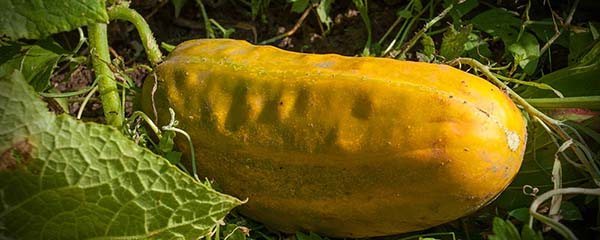

Maturity is determined by the color and condition of the peel, such a testis is called "yellow". Photo: countryhouse.pro
According to folk omens, the seed cucumber must be selected by the number of ribs on the walls, which correspond to the number of internal chambers. The quality of flowering depends on these signs. Seeds prepared according to this rule will produce female-type peduncles, which will increase the number of ovaries and allow for high yields.
There is no scientific basis for the influence of cameras / ribs on the future harvest, but many amateur vegetable growers adhere to this rule:
From gardeners
“The seeds are all taken out and washed in a colander until the mucus disappears completely. Then they are laid out on paper and dried on the windowsill. "
“If cucumbers remain in the garden by an oversight, I pick them when they are overripe. Already when cleaning the seeds, I cull and ruthlessly remove the frail, small, etc. The rest go through the procedure as described above. "
"I choose only round cucumbers, there are also triangular in cross section, which are not suitable for sampling seeds."
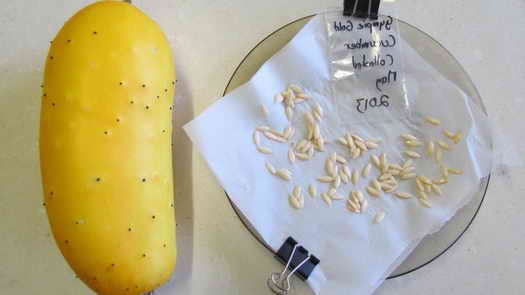

Collect cucumber seeds and trace your "pedigree" for this vegetable crop. Hybrids do not always justify themselves with crops.
Pro100ogorod for lovers of cucumber paradise.
Do I need to collect hybrids
Many summer residents prefer the cultivation of hybrid plants. The adherence to hybrids is understandable. Such vegetables are characterized by high productivity and excellent taste.
However, even if you liked the hybrid very much, it is not recommended to collect seed from it. Hybrids are obtained by artificial crossing of selected parent plants.


Seeds harvested from hybrid cucumbers in the future may give an unpredictable generation, or not germinate at all. If vegetables grow in the garden, then they will have nothing to do with the qualities that were so liked in the parent plants.
It is not difficult to distinguish hybrids when buying seeds in a store. The sachets will necessarily be marked with F1 or F2.
Similarly, it is better to abandon the idea of collecting seed from greenhouse cucumbers, since in most cases greenhouse varieties are seedless.
What cucumbers to leave for seeds: selection rules
The most important thing when choosing cucumber fruits from which we will take seeds is by accident do not take a hybrid variety... Because hybrids of any crops are completely unsuitable for seed propagation, since they have already been obtained by crossing several varieties, and therefore, if you sow such a plant, you will most likely get something completely different (in the sense of "unlike") to the desired vegetable. So leaving for seeds makes sense only varieties of cucumbers, not hybrids.
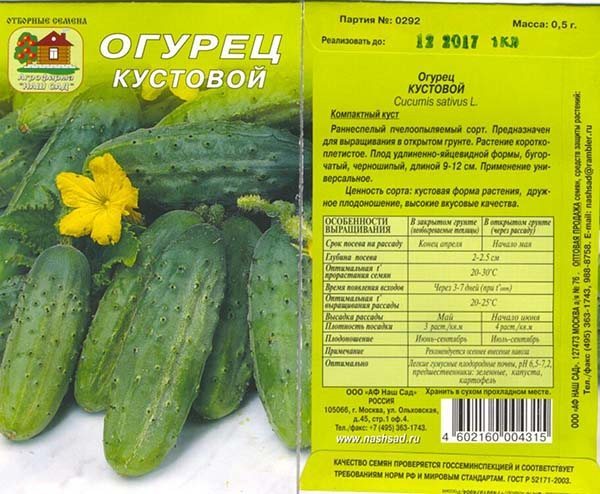

Varietal cucumber (non-hybrid)
Interesting! The F1 lettering on the seed package indicates that this is a first generation hybrid. That is, this plant was obtained by crossing two different varieties. Filli (F) from Italian - "children", 1 - "first generation". There are also F2.
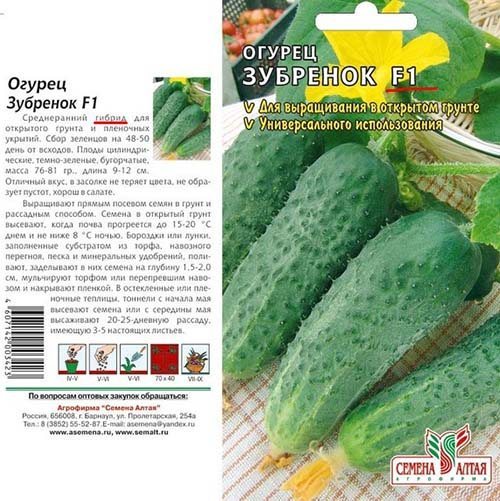

Hybrid Some gardeners argue that cucumber seeds should be taken from female cucumbers, which have four-chambered seed septa.
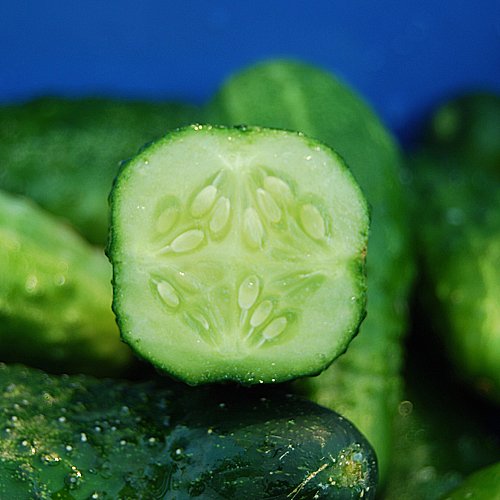

Male ones have three seminal chambers.
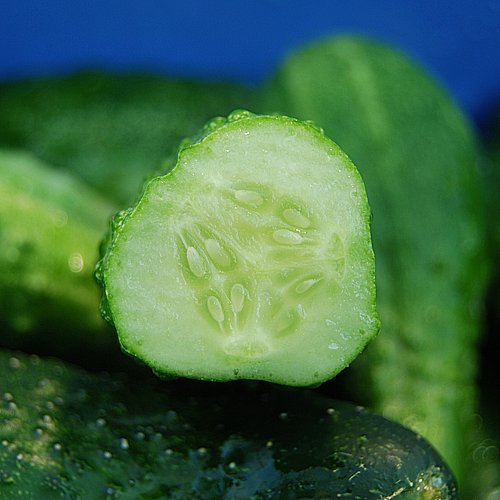

Thus, it is possible to determine that a cucumber is a "girl" by its appearance (it is not necessary to cut it at all), the fruit should have, as it were, 4 faces, respectively, the "boy" - 3.
What do cucumber seeds look like?
After collecting the seeds, inspect them carefully. They are in a special shell that deteriorates very quickly. This shortens the shelf life of the seeds. To remove it, dry the seeds in the sun for 3 days, and then rinse off the remainder with water.
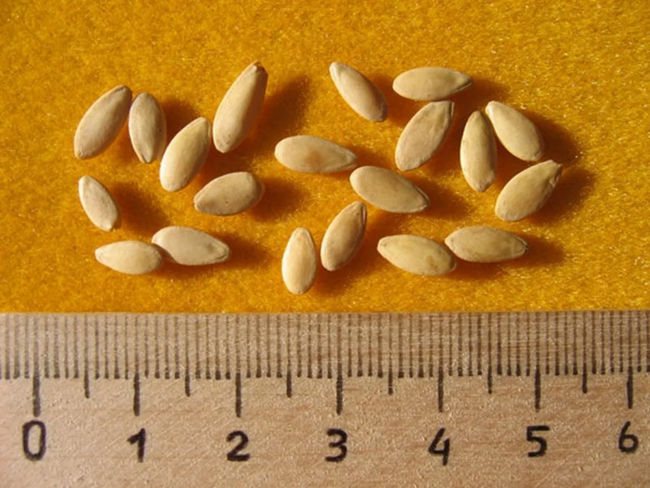

We've all seen seeds like this in cucumbers.
High-quality seeds have the same, uniform color with a light cream shade. Depending on the variety, they can be of different sizes.
Get quality cucumber seeds: instructions
The seed-fruit that has lain on the melon for at least 50 days is torn off and transferred to the house. Take your time with the selection of seeds. Proceed in stages and sequentially:
| Stage 1. Maturation After being removed from the garden, the zheltyak should lie in a warm room / greenhouse or in the sun for 1-2 weeks. During this time, it will finally mature. As soon as it loses its elasticity and becomes soft, you can start picking seeds. |
| Stage 2. Sampling The highest quality seeds are located in the middle part. Cut the body in half / lengthwise and start collecting. Take a bowl or other deep container and scrape out the inner gruel. It is better to take out the seeds with a spoon, it cleans out the middle with the pulp, which is necessary for ripening. If the fruit is rotten, remove this part, and rinse the collected material in a weak solution of copper sulfate |
Further steps to collect seeds from cucumbers
The cucumber is cut lengthwise (in half). Seed material is taken from the anterior third of the fruit.
The contents of the seed chamber are cleaned into a glass container. If there is little liquid in it, you need to add a little water to the bowl.
Put the jar in a warm place for two days. During this time, fermentation will occur and the amniotic membrane will separate from the seeds.
Rinse the seeds in running water. Note that good quality seed (heavy) will settle to the bottom. The lungs will remain on the surface. Pour them along with the pericarp and pulp.
Clean seeds are dried on plywood or cardboard with a thin layer. At night, they clean up the room.
Find out How to properly collect tomato seeds at home.
How to harvest cucumber seeds for future harvest
A fully ripe seed cucumber is torn off after the stalk has dried. The greener the latter, the more nutrients the vegetable lacked. But if there is too much humidity outside, severe very early frosts hit, it is advised to choose the ripening option on the windowsill (7-10 days).
Having received the necessary cucumber for seeds, the correct collection of the seed begins with cutting off the back part (approximately ¼ of a share), cutting the remaining vegetable in half. Then, using a small spoon, all the insides (seeds and pulp-pulp) are removed and placed in a separate container. Preference is given to glass, enamel or plastic dishes, but not iron.
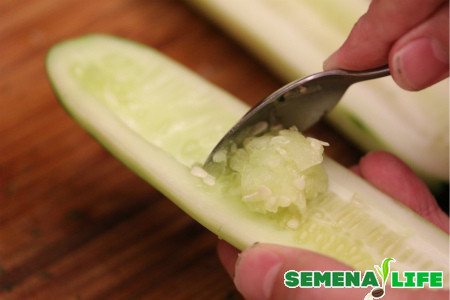

The next stage is the process of fermentation (decay) of the resulting material. This is necessary in order for the shell of the seeds to get rid of the blockers of germination, which counteract the flow of this process inside the vegetable. This cannot be achieved without rotting (fermentation).
How is the fermentation (fermentation) process carried out
Fermentation and rotting of the seed coat allows you to obtain a refined seed for sowing. Everything is carried out as follows:
- seeds with mucus are placed in a jar;
- a little water is added;
- the neck is closed with gauze or cloth;
- the container is placed in a warm place for 2-3 days;
- the fermented mass is transferred to a sieve;
- everything is washed several times under running water.
It is not difficult to understand that the liquid has fermented. This will be seen by bubbles on the surface, sometimes by areas of mold, and also heard by a specific unpleasant odor.
Then the seeds are put into a bowl and filled with water. All high-quality, healthy seed settles to the bottom, and empty, unsuitable particles float to the surface and are removed. It is advised to repeat this selection 2-3 times.
After all the cleaning manipulations, the remaining seeds are laid out on a film, a plastic board, a cloth mat, and placed in a warm place for drying. It is advisable to mix everything every 1-2 days. Leaving the seeds on the paper surface is not recommended as they can stick.
Remember
- Know the grade. Pancreatic hybrids bred for greenhouses will not self-pollinate. All hybrid varieties lose their properties, change the ripening period, length and shape of the fruit.
- Don't leave a lot of fruit... Zheltyak draws a lot of strength from the bush, reduces productivity. The scourge stops growing and forms less peduncles.
- Choose a healthy bush. If the bed is affected by powdery mildew, putrefactive infections, fungi, the planting material may be infected.
- Comply with the terms and rules of processing. Do not rip off the yolk until the whip and stalk are dry. Use the fermentation method. Rinse and dry the seeds according to the rules.
Home-grown seeds will not only help you save money - they are adapted to your climate and will delight you with an excellent harvest.
Conditions for harvesting cucumber seeds
Harvesting cucumber seeds from your own fruits has its own nuances. In addition to the basic rules, there are other factors that can affect getting a good harvest from your own harvests.
The first thing to pay attention to is whether it is a hybrid variety, and the second is the shape of the fruit. It turns out that thanks to these two indicators, the yield is determined. Cutting the cucumber itself and selecting the seeds will also greatly affect the quality.
Assembly features
Important! Storage and preparation for planting are important and even basic conditions. Many inexperienced gardeners neglect these steps and, as a result, face problems in the course of growing cucumbers.
When to collect seeds?
In order to preserve the quality characteristics of the variety, the next year many fruits ripened on the bushes, delighting with their bright green color, delicate taste, seed cucumbers are left on the whips until frost. The grains must survive not only the summer heat, but also the autumn temperature fluctuations. After natural stratification, next year sprouts will sprout together, a lot of ovary is formed, on which cucumbers will tie.
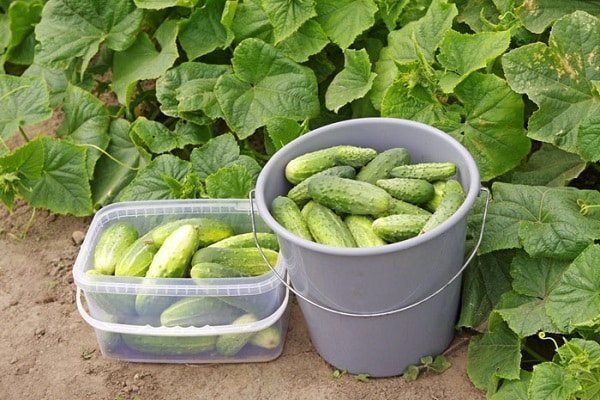

These green fruits contain enzymes, thanks to which animal fats are absorbed faster. They contain vitamins, iron, magnesium, phosphorus, and calcium. Fiber normalizes bowel function. Alkaline salts neutralize acids, prevent the conversion of carbohydrates into fats.
See also
Description and characteristics of the German cucumber variety, planting and careRead
Seeds are selected when three conditions are combined:
- the fruit becomes brown;
- the cucumber becomes soft;
- the tail dries out.
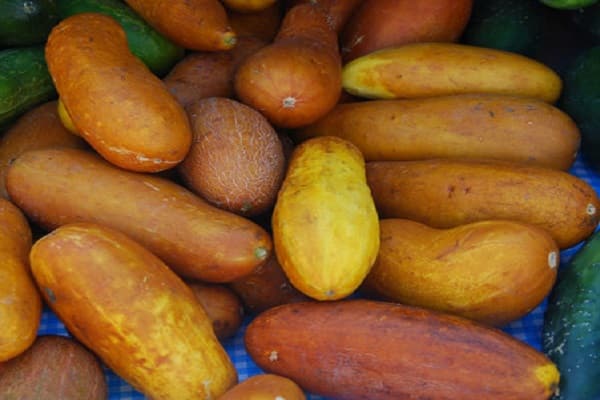

From such grains, you can get the harvest for the next year. They will retain their properties for several seasons.
How to determine if the selected cucumber is ready for harvesting seed
First, you need to determine exactly that the cucumber is ready, and you already need to take it and extract the seeds. This can be done according to the following criteria:
- The cucumber turned yellow, acquiring a brownish tint, and reached an impressive size.
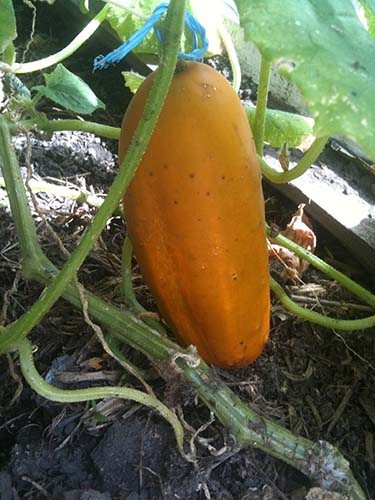

- The tail (stalk) is completely dry... This means that the fruit has completely absorbed all kinds of nutrients necessary for the ripening of the seeds. If the tail is still green, then you need to wait, the process is not over yet.
Testimonials
An overripe cucumber can be left for seeds only if it is not a hybrid and cucumbers of another variety did not grow next to it within a radius of at least 200 m, otherwise even if your cucumber is of a non-hybrid variety, it is still dusty and it is not known what will grow out of it ... These conditions are practically impracticable. You can, of course, leave it on seeds for the sake of experiment, but then plant these seeds separately. The seeds must be squeezed out together with the juice, which is in the middle of the fruit, i.e. scrape out the middle as it is. Place all this in a cup and leave for 1-2 days for fermentation, then the seeds will separate well from unnecessary pulp. Then rinse well under a thin stream of water, put everything that remains at the bottom on a napkin and dry. Throw away the seeds that float.
Medic
I have been planting cucumbers from my seeds for many years in a row, they sprout better, stronger sprouts. But with cross-pollination, you can really get into trouble. For seeds, I usually leave the most beautiful cucumber with the most pronounced varietal characteristics from the first harvest. Then everything, as Medic wrote. The only thing I want to say is that the yield from the seeds collected with my own hands is much higher in 2-3 years, therefore I plant the seeds of the year before last.
Nfif
Pollination of cucumbers to obtain seeds
All varieties of cucumbers are divided into two types:
- self-pollinating or parthenocarpic;
- bee-pollinated.
In the second case, there is a risk of getting a hybrid rather than a pure variety. This method is suitable if the variety of cucumber does not matter. But if you want to get only a certain species, then manual pollination is necessary.
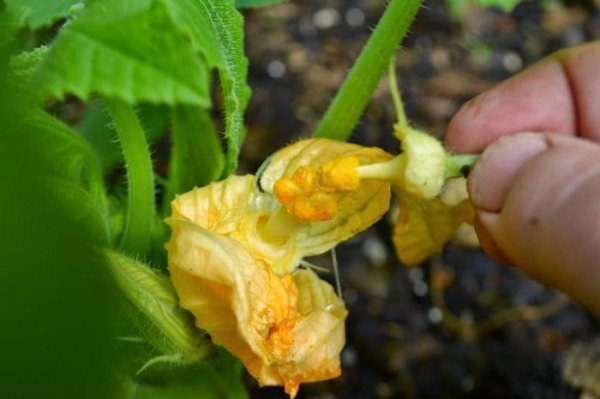

Manual pollination of cucumbers to obtain seeds
To do this, a day before the blooming of the buds, carefully tie the male and female flowers so that insects do not pollinate them. You need to tie male buds 2-3 times more than female ones, so that then each female bud is pollinated with two or three male buds. After a day, remove the cotton wool and start pollination. This should be done in the morning in dry and warm weather.
Cut off the corollas of male flowers and gently touch them to the stigma of female flowers. Each flower needs to be pollinated with 2-3 male ones. Repeat as many times as you want seed cucumbers. Also, with the last male flower, close the entrance to the female flower, leave it with the peduncle and the calyx to prevent insects from entering. We have already touched on the topic of male and female flowers in a cucumber and how to determine them in the article Why there are a lot of barren flowers on cucumbers and how to deal with it.
At the end of the procedure, mark the pollinated flowers with colored ribbons.
When is the collection
To get high-quality seed, they begin to collect it only after the final ripening of the vegetable. In most cases, the vegetable has time to fully ripen three to four months after the first shoots appear.
The optimal time for harvesting is right in the late summer or early autumn. By this time, the vegetable has already acquired an orange or bright yellow hue. Experienced vegetable growers prefer to harvest fruits that have been set aside for full ripening after the first frost. The temperature difference has a beneficial effect on the embryos, the chances that the seeds will germinate well next year and ensure a high yield increase significantly.
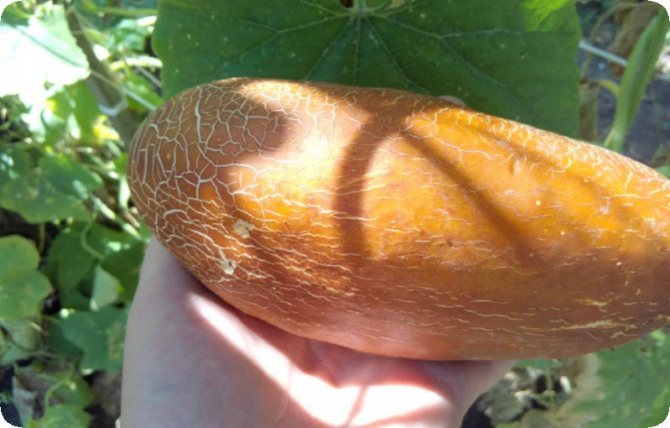

If for some reason it is necessary to remove the cucumbers earlier from the garden, they are laid out to lie on the windowsill until fully ripe for 1-2 weeks.
The choice of planting material
Any cucumber seeds are planted in a special way and require preliminary harvesting. There are such seeds of domestic cucumbers:
- Regular - are sorted, where, under special conditions, hollow seeds and suitable for planting are packed separately. You can get a full-fledged planting raw material by dipping it into salt water.Those that have sunk to the bottom are suitable.
- Processed - are treated with antifungal drugs and nutrient reagents.
- Calibrated - require warmth and moderate moisture. Failure to comply with the rules of storage and planting leads to a decrease in the percentage of germination. Such seeds are placed on a damp gauze cloth and stored at a stable temperature up to 300C.
Tip: When the seeds begin to sprout, they can be planted in the ground.
Seeds from the store: secrets of choice, planting features
If you are not ready to collect seeds yourself, go to the store, but before buying, decide what you want to buy - a cucumber variety or a hybrid? The variety is cucumbers obtained by crossing one species... When planting varietal cucumbers on the main stem, male flowers are the first to bloom, slowing down the growth and development of the plant. The harvest of such cucumbers appears much later, therefore, at the initial stage, all male flowers are removed. When the lash reaches 70 cm in height, the main stem is pinched. Thus, female flowers appear on the lateral shoots, which give a crop.
In contrast, in hybrids, female flowers appear first. Those that bloom below also need to be cut off until the stem reaches 70 cm in height... Then the plant will get stronger: the stem will become thicker, a large leaf will appear and, as a result, a high yield. By the way, when choosing between varieties and hybrids, remember that the latter are more resistant to disease and temperature changes.
A rule to remember: self-collected seeds of varieties can be sown, but seeds of hybrids cannot.
Pay attention to the description of the species. If the package says "bee-pollinated", it means that the ovary will appear only after pollination and not necessarily by bees - the flowers are pollinated by other insects. If the plant is parthenocarpic, then it does not need pollination.... Such cucumbers are suitable for planting in greenhouses, where insects are extremely rare.
These two species should not be planted side by side: a number of parthenocarpic hybrids do not respond to pollination, but some of them may deform after this process.
We grow cucumber seedlings from harvested seeds
The root system of cucumber plants is very vulnerable, so it is better to initially sow the seeds not in a box, but in separate cups, peat pots or paper bags, so that later not to damage the roots during transplantation. The soil can be purchased ready-made or independently mix three parts of decomposed peat, sod land, humus and one part of river sand. Add urea (1 teaspoon), superphosphate (1 tablespoon) and wood ash (3 tablespoons) to a bucket of prepared mixture.
Hand-picked cucumber seeds should be prepared as follows:
- warm up for two weeks in a bag in the sun or near a battery;
- pour the seed material with hot water and hold it in a thermos for a couple of hours to improve germination;
- remove all injured and weak seeds;
- pickle for half an hour with a solution of potassium permanganate;
- rinse thoroughly in clean water;
- soak in warm water until a small root appears on the third day.
Sprouted seeds must be sown immediately into the ground so that the sprouts that have just started to grow do not die. Spread the seed material over the soil surface (2 pieces in one pot or cup), sprinkle it with soil with a layer of 1.5 cm. Lightly sprinkle the soil with warm water, no need to water, otherwise the seeds will be pulled deeper into the ground.
Next, set the cups tightly into the boxes and put them on the window (preferably south) or in the greenhouse, covering the boxes with foil. The temperature needs to be maintained at + 25 + 28 degrees, then you will see the first shoots after three days. With the emergence of seedlings, remove the film and move the box to a window with good lighting, while the temperature will need to be reduced to +19 degrees and +14 degrees at night so that the cucumber seedlings do not stretch. You can regulate the temperature on the windowsill using a window, and in cloudy weather, you can additionally illuminate the plants with a fluorescent lamp, providing them with daylight for 10 hours a day.
Watering the seedlings of cucumbers with warm water begins when the first cotyledon leaves unfold, it should be watered with a teaspoon, avoiding excess water.Ready seedlings are planted in open ground by transshipment - moving the plant along with a lump of earth into a prepared hole.
How to prepare seeds for planting
The most suitable for placing in the soil is seed harvested 2-4 years ago. Using earlier seeds, it is believed that the harvest can be poor or late, as there will be a lot of male barren flowers.
If there are only 1-2 year old seeds available, but you really want to plant them, it is advised to hang the bags from the ceiling in a warm room a couple of months before planting. Some gardeners use the method of calcining the seeds before sowing in the oven (1.5-2 hours at a temperature of 40-50 degrees). But this technique harms future vegetables.
The process of independent home harvesting of cucumber seeds from the existing crop harvest is simple and efficient. As a result, you can be sure that you will be able to grow the desired variety with your favorite taste on the garden bed. In addition, ardent gardeners get the opportunity to experiment, test various variations in the choice of seeds.
How to choose the right cucumber for collecting seeds
First of all, the varieties of crops that grow in your garden are distinguished, which suit the taste, giving good quantitative indicators. Thus, precise confidence in the quality of the obtained seed material is ensured. An important nuance is the selection of exclusively varietal crops, and not hybrid ones that will not yield a harvest.
Further, on each separate lash of a healthy strong plant, 2-3 cucumbers are selected that meet the following conditions:
- large size;
- smooth sidewalls without dents, damage;
- yellow, yellow-brown skin color;
- softened structure;
- dried stem (tail).
It is recommended to mark the cucumbers for seeds in advance, even before they begin to turn yellow. A colored rope, gauze pocket or other marking option will come to the rescue. A slightly larger number of copies are selected than necessary, in case a part decays or accidentally breaks off.
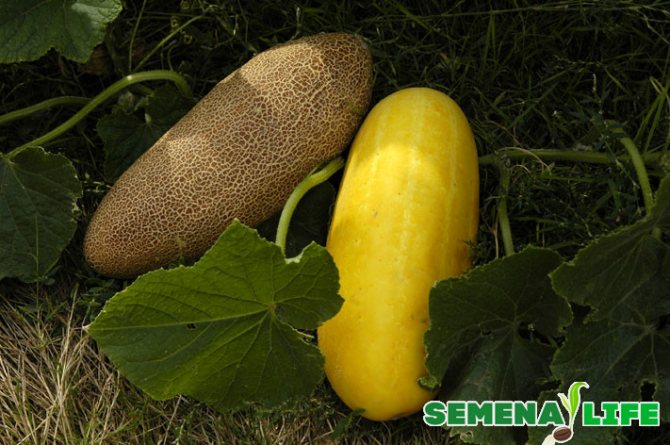

Selected representatives gather as late as possible in the fall. This will allow the seeds to fully ripen and become more resistant to both heat and cold temperatures. If it rains often, there is a high moisture content in the soil, a wooden stand is placed under the cucumbers.
People's councils, not confirmed by breeders, speak of the need to select only tetrahedral (female) specimens. Tripartite cucumbers are considered male barren flowers, yielding much later. Also, for seeds, only half of the vegetable is used, which was closer to the stalk, in order to avoid further bitterness and unpleasant taste.
Storage features
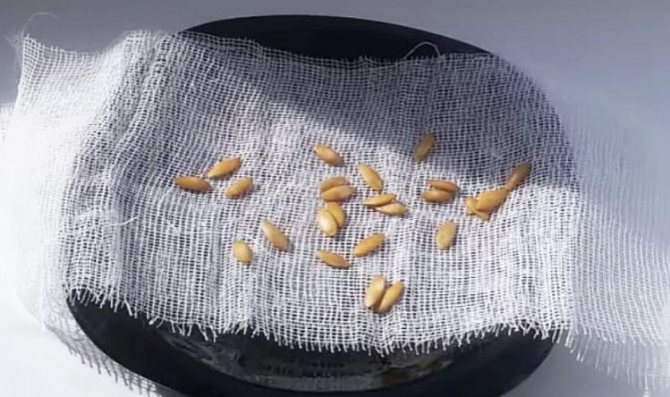

If you collected seeds from correctly selected cucumbers and did everything according to the instructions, then you will not have to doubt their quality. The sowing capacity lasts up to 6-7 years. Collect the dried grains and transfer them to a clean paper envelope, be sure to sign it so you know which variety is stored there. The room where the seeds are stored should not be cold or humid. With a moisture content of more than 60% and a temperature below 10 degrees, the seeds quickly become damp, they are not suitable for sowing. Do not store seed near heating radiators, on stuffy mezzanines. If the seeds lie all winter at room temperature, then their germination will only last for a year.
You can grow seedlings from harvested cucumber seeds for a year. Immediately after collection, it is not worth using them for planting: the shoot will be low. Before sowing them into the ground, first treat the seeds in a disinfecting solution (soda or saline solution, potassium permanganate). For good germination, agronomists recommend germinating grains. Put them on a napkin soaked in a growth stimulator, then put them in a dark place and germinate for 4-7 days.
Harvesting cucumber seeds is easy, just try it once and you no longer have to buy expensive bags at the store. Do not forget to carry out their subsequent preparation before sowing, and a rich harvest of crispy tasty greens will be provided to you.
Gardening
Getting your cucumber seeds takes a little work.
The seeds inside the cucumber are stored in the seed coat, which contains inhibitors, substances that slow down the development of seeds and prevent them from germinating inside the fruit.
In nature, after ripening, the cucumber rots and decomposes, and the seeds, no longer inhibited by inhibitors, germinate. In order to harvest your cucumber seeds, you need to artificially speed up this process.
This is necessary in order to get cucumbers with the best set of genes next year, this is how breeding has been going on for centuries - people collected seeds only from the largest and most delicious fruits of plants.
Do not harvest seeds from plants grown from F1 hybrids.
Just do not collect seeds from plants grown from F1 hybrids (see the article F1 Cucumbers - what does F1 mean in the variety name?), You will not be able to get any predictable harvest from these plants.
Experiments have not shown any dependence of the yield on the number of edges.
Sometimes gardeners recommend collecting seeds only from tetrahedral cucumbers, and not using triangular cucumbers to obtain seeds, however, experiments have not shown any dependence of the yield on the number of edges.
In addition, it is recommended to collect seeds only from the front of the cucumber (where the flower was) so that the fruits do not taste bitter the next year, however, most likely, this is also a myth.
An overripe cucumber swells, becomes yellowish and even a little brown - all this indicates that the seeds are ripe. Pick a cucumber and leave it on the windowsill for a few days to soften.
For easy access to the seeds, cut the cucumber lengthwise
For easy access to the seeds, slice the cucumber lengthwise and scoop out the seeds with a spoon into a container such as a plastic cup. Don't forget to sign the grade!
Fermentation helps to separate the seeds from the pulp and destroy any remaining germination inhibitors.
Place the seeds in a small jar, add a little water to let the seeds float freely, and cover the jar with gauze (this will prevent flies).
After 2-4 days, fermentation will be complete, and the mixture itself will look and smell not very pleasant (most likely, a mold film will even grow on its surface) - this is normal.
Do not leave seeds in this state for longer - they may begin to germinate.
Good seeds will sink to the bottom, and empty seeds will float up.
Remove the mold layer, add water and shake the jar a little - this will make it easy to drain all excess, because good seeds will settle to the bottom, and empty ones will float. Then place the seeds in a colander and rinse well under running water.
Spread the seeds out on a saucer or cling film and place in a dry, warm place where they can dry completely.
Do not use paper for drying - the seeds can dry on it
Do not use paper for drying - the seeds can dry on it, and afterwards it will be quite difficult to separate them. The seeds can be agitated every few days so that they do not stick together and dry evenly. Do not use heat sources to heat seeds to dry them out faster.
Seed cucumber signs and ripeness
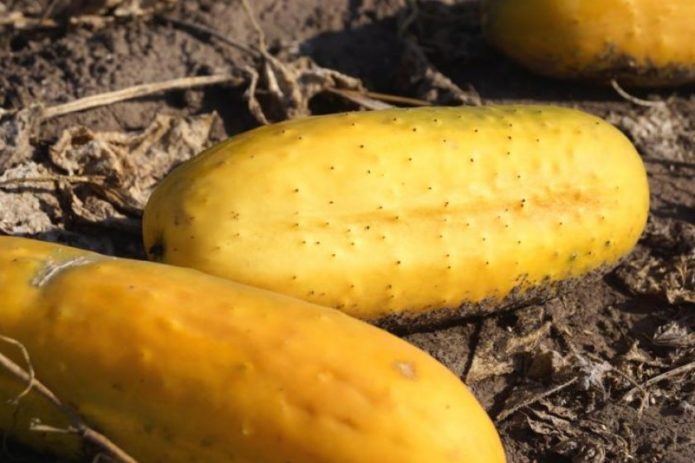

Almost any cucumber varieties are suitable for collecting seeds, but only with the exception of hybrids. The latter is bred by crossing several species, but what kind of harvest it will give in the future is unknown. The vegetable is not able to reproduce the previous characteristics, therefore, when planting seeds of hybrids, ugly and tasteless vegetables often grow. Consider this fact when choosing a seed cucumber.Do not pluck the fruit from the greenhouse, as most hybrids are grown in greenhouses.
The right time for collecting testes is in late summer - August. When the cucumbers are still ripe on the branches, spot a few fruits. Choose "girls": these are greens with 4 seed chambers, they immediately differ from others in their convex shape. "Boys" have only 3 protruding edges, and the grains harvested from them are mostly empty flowers. In order not to confuse which cucumbers will be used for seeds, mark them. You can tie a colored string around the stem or stick in a stick. Make sure that the weight of the fruit does not touch the ground, otherwise it will quickly rot. Put a cardboard box, a board on the ground, then the vegetable will ripen normally.
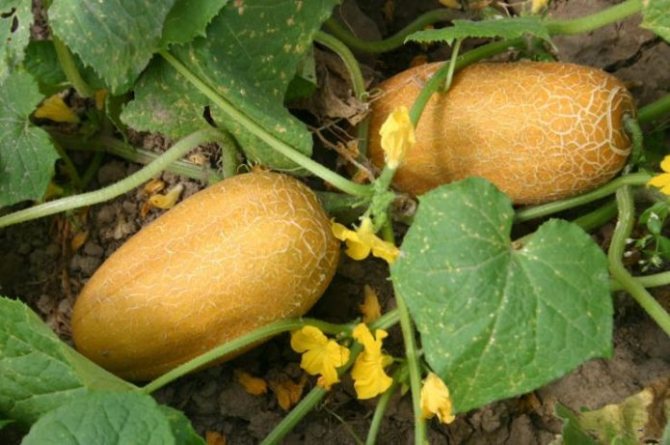

To understand whether the testis is ready or not, there are several signs. If you saw them, then pluck the fruit without hesitation:
- the cucumber has reached the specified size and fully corresponds to the description of the variety;
- the fruit turns yellow;
- the skin becomes brownish and soft;
- the stalk dries up.
If you have not noticed any of the things listed on the fruit, do not rush to pick it and wait a little, perhaps soon the fruit will reach full maturity. If the weather is sunny, no rain is expected, then the testis ripens in a couple of weeks or less. In the case when frosts have come to the region, precipitation is expected, it is better to pick the greens in dry weather. They will ripen normally at home: just put them in a warm place, and in a couple of weeks the fruits will be ready for harvesting seeds. It is not permissible to get moisture on the skin: this leads to the formation of rot and mold, and it is impossible to collect grains from such vegetables.
When ripening cucumbers at home, do not forget to turn them over so that the skin "does not lie down", so the seeds will ripen evenly.
Rules for self-collection of cucumber seeds. Description of the best varieties
It is not enough just to collect and prepare the seeds, you also need to dry them for storage at home. The cleaned and washed material for future plantings should be spread out in a thin layer on a cloth or paper and left to dry naturally, gently stirring occasionally. You can speed up the drying of seeds at home only by ensuring air circulation, you should not heat them. If it is still warm outside during the day, you can take the seeds out into the air, and clean them at night.
To get your own cucumber seeds, which will give a good harvest in the coming season, they must be properly harvested and stored until spring. We'll show you how to do this.
First of all, please note that not all cucumbers are suitable for harvesting seeds. After all, a competent choice of fruits is half the success.
Do not flatter yourself. The article provides information on how to choose the right variety and prepare the seeds of the plant you like on your own in order to stay with the harvest, and not with the nose.
The varieties and hybrids of green vegetables allowed for planting on the territory of our country are taken into account by the authorized body - the State Commission of the Russian Federation for the Test and Protection of Breeding Achievements (FSBI "State Sort Commission"). At the beginning of 2020, 1,340 varieties and hybrids of cucumbers were registered. Of these, 82 varieties, the rest are hybrids.
(Official table with full specifications.)
Seed selection
When choosing a suitable vegetable, take into account:
- Landing tolerance region. The country's territory is divided into 7 climatic zones.
- The purpose of the vegetable is salad, canning, universal.
- Ripening period.
- For open ground, a plant is intended or for a greenhouse.
- Bee-pollinated cucumber or parthenocarpic.
It is worth clarifying point 5. On the packages, in addition to indicating that this variety is bee-pollinated or carp, sometimes there is a definition of "self-pollinated". Let's clarify.
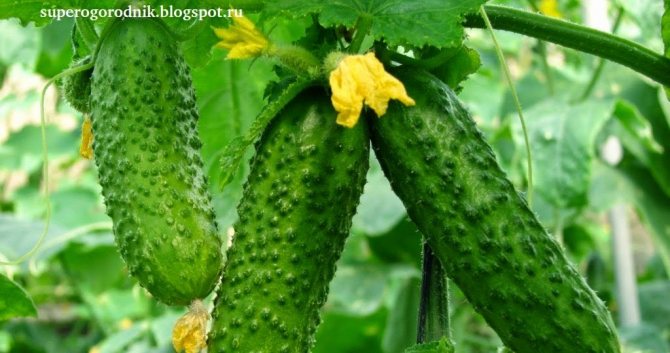

Bee-pollinated varieties for setting fruit need pollination - the transfer of pollen from male flowers to female flowers. Insects are engaged in this. In industrial greenhouses, houses with bees, more often with bumblebees, are specially installed.
In a home greenhouse from October to March, pollinating insects have nowhere to come from. Be careful when buying.
But the inscription "self-pollinated" misleads an inexperienced buyer. Bees are needed for pollination. The characteristic suggests that there are female and male flowers on the same plant, and they can be pollinated, unlike cross-pollinated varieties, which require a neighboring pollinator plant.
If the grower has put two types of seeds in the bag (differing in size or color), plant both varieties alternately. The second plant is used for cross-pollination.
Incomplete information does not make it possible to choose a variety that is suitable for specific growing conditions.
The hybrid you like will have to be bought every year. Plants obtained from such planting material lose their parental characteristics - it is not known what will grow in the garden. Seeds in hybrids are often underdeveloped.
Seed collection
In order to properly collect fruitful cucumber seeds, simple rules are followed.
Suitable cucumbers
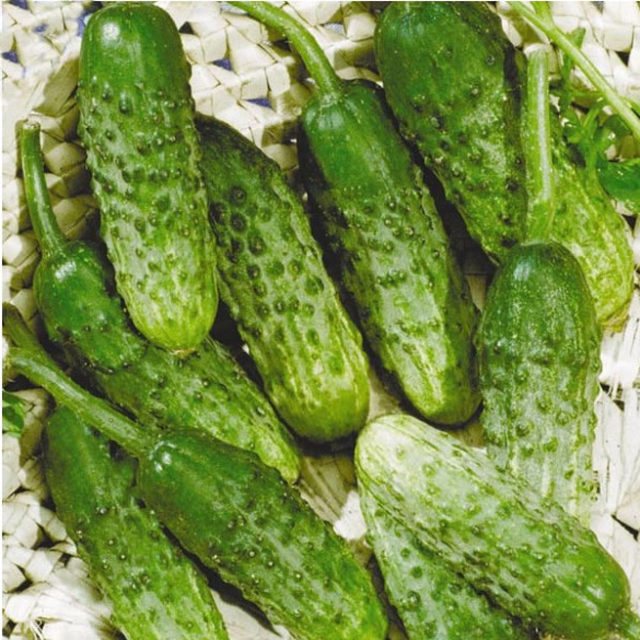

To collect seeds, first determine the bush from which the fruits will be "correct". Plants that are lagging behind in development with a small number of female flowers and ovaries are not suitable. During the growing season, all fruits of an atypical species are removed from the bush you like.
When harvesting seed, you must follow the following rules.
Rule # 1
First of all, it is necessary to leave the overgrown fruits growing on the most powerful bushes. So that no one inadvertently rips them off, it is recommended to mark them in some way: tie a colored thread, a piece of bandage at the stalk, wrap it in a rag or paper. While the ripening process is in progress, put any insulating material under the cucumber - a piece of wood, a piece of plastic, etc., otherwise it will start to rot from the ground.
Rule # 2
In late summer - early September, you see the finally ripe cucumber. This is evidenced by the huge size of the fruit of a yellow-brown color with a dried tail. This means that the fruit has absorbed all the nutrients needed by the seeds, and no longer needs them. A green tail that has not dried up indicates an unripe seed that still needs nutrition. Such a fruit is not suitable for obtaining seeds.
Rule # 3
From the collected cucumbers, female fruits are selected. It is from them that future seeds are collected. Check all the cucumbers and keep the square-female 4-chamber fruits. Male fruits are 3-chambered. See how they look in the photo.
Rule # 4
Most often, the dry-tailed cucumber tip is bitter. You need to get rid of it. For the seeds contained in the tip are bitter. Cut off the bitter tip about 3-4 cm.
Cut the remaining part in half lengthwise and scrape the seeds together with the transparent pulp into a glass jar with a spoon. It turns out a gruel from seeds with pulp.
Rule # 5
We draw attention to one more important point. Each seed is in a transparent shell. They must get rid of it, so that later the seeds are stored longer. Without removing it, the seeds will not be able to be stored for a long time, they will begin to deteriorate. And we need the seed material to be stored for at least 3-4 years. Therefore, we leave the jar with seed gruel for 2-3 for fermentation. After fermentation, the shell is destroyed, then it is quietly removed.
Rule # 6
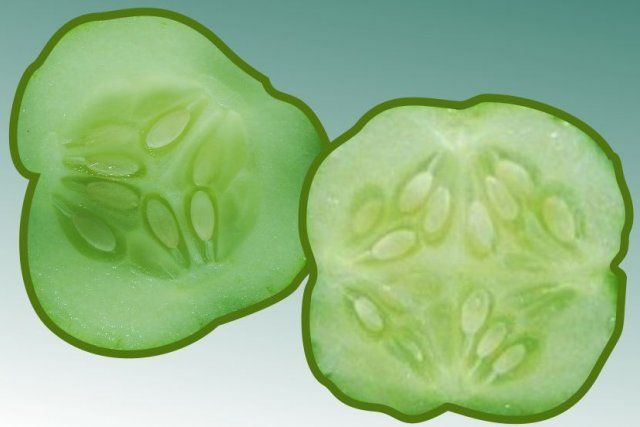

To remove the shell from the seeds, add water to the jar after 3 days. Stir the contents thoroughly, so the remaining shell is better destroyed and well exfoliated from the seed. In water, full-weight seeds sink to the bottom. Others, not bearing a sprout, float to the surface, they are simply removed.
The remaining full-weight seeds are poured onto a sieve. Under running water, continue to rinse them thoroughly until the final disposal of the shell.
The washed seeds are spread in a thin layer on a plate covered with a film. On paper, subsequently dried seeds will be difficult to pull off.The prepared seeds are harvested to dry in a warm place at room temperature, for example, on a cabinet, and left there for 7-10 days. Do not forget to sign the seeds if you are harvesting more than one variety.
The dried seeds are transferred to paper bags, again, do not forget to sign which variety is inside and the year it was harvested. The bags are stored in a dry, dark place.
When the stalk is dry and the fruit has softened, detach it from the whip. Then cut it in half lengthways and remove the back: cut off 2-3 cm of the fruit and discard, since the tasteless fruits grow from the seeds of this zone with bitterness.
Remove the seeds from the seed chamber and place in a glass container. Fill the container with water 2/3 and leave for two days in a warm place. After this time, pour water to the top and stir. This is necessary so that the light (empty) seeds float up and the amniotic membrane separates. If it remains on the seed, it will inhibit germination.

